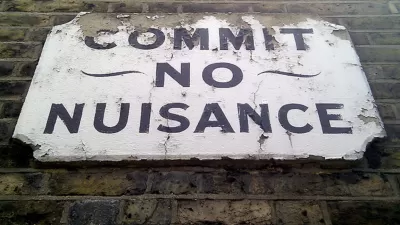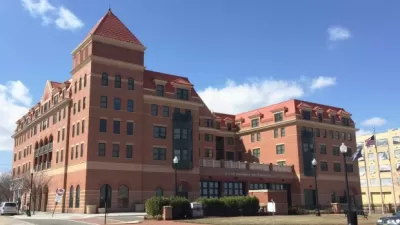In one Texas case, homeowners are suing a new apartment building for nuisance. If such suits become common, infill development will become less common, causing higher rents and more citywide vehicle traffic.

In the recent case of Loughead v. Buckhead Investment Partners, a group of Houston, Texas homeowners filed a common-law nuisance action to prevent a developer from building an apartment building in their neighborhood; the plaintiffs asserted (among other claims) that the apartments caused increased traffic—a claim that would be true of any new housing. Under the law of nuisance, a landowner may recover damages whenever another person uses their land in a manner that causes substantial, unreasonable harm to other landowners. A jury awarded the plaintiffs damages in December 2013, and the verdict will be appealed.
The landowners sued for nuisance because Houston has no zoning code and the city could therefore not legally exclude the apartments—but at common law, something permitted by zoning can still be an actionable nuisance. So if the Loughead action is upheld on appeal, landowners all over the country may become more willing to file nuisance actions to keep out multifamily housing (or for that matter, any other allegedly undesirable land use).
It seems to me that states should prohibit nuisance claims against new multifamily housing (either through state legislation or through judicial decisionmaking), for three reasons.
First, the public policy in favor of affordable rental housing dictates against such actions. Throughout the United States, there is a rental housing shortage. Between 2000 and 2013, median household income has increased by 25.4 percent, while rent has increased by 52.8 percent. The explosion in rental costs has not been limited to gentrifying, traditionally high-cost cities such as San Francisco and New York. For example, in Hattiesburg, Mississippi, rents increased from 20 percent of household income in 1979 to 35.2 percent in 2013. The explosion in rents is in large part the result of increased demand for rental property; tighter credit standards and stagnant wages have kept would-be homeowners from buying houses and forced them to rent instead. The supply of multifamily housing has increased, but not fast enough to keep up with increased demand: the national rental vacancy rate (8.3 percent) is at its lowest point since 2000.
If (as in the Loughead action) homeowners are allowed to use nuisance law to keep multifamily housing out of their neighborhoods, the shortage of rental housing is likely to get worse, causing rents to continue rising. If would-be landlords can only build in places far from single-family homes, the possible supply of land available for multifamily housing will decrease, and the number of new units will decrease.
Second, the public interest in promoting infill should bar such nuisance suits. Because most land is zoned for single-family housing, most of urban America is near a single-family neighborhood. In Houston, for example, single-family housing takes up 67 percent of all land and 95 percent of land used for housing. Even in relatively dense Boston, single-family housing takes up 56 percent of all land and 88 percent of land used for housing. So if apartments near single-family homes were a nuisance, almost every new apartment building in the United States would be a nuisance. If apartments could be built at all, they could only be built in “greenfield” locations—that is, in exurban places far from existing development. But the public interest favors building multifamily housing in existing urban neighborhoods and inner suburbs, especially if those neighborhoods are near downtown and/or densely developed. Existing neighborhoods near downtown tend to be less dependent on automobiles than greenfields, for two reasons. First, transit networks have historically been centered near downtown business districts so neighborhoods near downtowns tend to have the most convenient transit service and the highest transit ridership. Second, compact neighborhoods tend to have higher transit ridership than thinly populated places; if only a few houses can be built on a block near public transit, only a few houses can access such transit. Neighborhoods near downtown tend to be more compact, and thus can support more transit service. It follows that if new housing is built in unpopulated greenfields, the residents of this new housing will be more likely to drive and less likely to use other modes of transportation, thus increasing citywide congestion and pollution. And since renters tend to be poorer than owners, they are less likely to be able to afford the added costs that come from living in automobile-dependent neighborhoods.
Third, in cities with zoning, the public interest in orderly planning should support strict limits on nuisance actions designed to stop new development. (Obviously, this argument does not apply to Houston, which lacks zoning.) One purpose of zoning is to allow cities to create an orderly plan of development for the entire city, as opposed to just one land owner or group of landowners. But if anyone who dislikes an apartment building (or any other controversial land use) can file for nuisance, the location of land uses can be determined by a small number of landowner plaintiffs and by juries, neither of whom are as likely to be as familiar with citywide interests as a city council or zoning board.
Admittedly, land use in cities with zoning is already heavily influenced by “Not In My Back Yard” (NIMBY) activists. So why is nuisance NIMBYism worse than zoning NIMBYism? Zoning decisions are usually made by elected officials, who are unlikely to limit development unless some critical mass of NIMBYs want to stop it. By contrast, just one landowner can file a nuisance action, even if the landowner’s own neighborhood does not oppose the new development. So if nuisance actions are used to create yet another form of “NIMBY veto,” citywide interests become even less important in the land use process.
The Loughead plaintiffs argue that their suit is necessary to prevent their neighborhood from being deluged with traffic. I don’t find this argument persuasive even in Houston, because if new residents and their cars are kept out of one neighborhood, they will merely create traffic somewhere else, and will probably wind up driving their cars through the plaintiffs’ neighborhood. But even if this argument is sensible in Houston, it does not justify nuisance actions in cities with zoning. In those places, arguments about traffic, noise, etc., should be made before city councils and zoning boards, who can balance neighborhood concerns against broader citywide interests.

Planetizen Federal Action Tracker
A weekly monitor of how Trump’s orders and actions are impacting planners and planning in America.

Map: Where Senate Republicans Want to Sell Your Public Lands
For public land advocates, the Senate Republicans’ proposal to sell millions of acres of public land in the West is “the biggest fight of their careers.”

Restaurant Patios Were a Pandemic Win — Why Were They so Hard to Keep?
Social distancing requirements and changes in travel patterns prompted cities to pilot new uses for street and sidewalk space. Then it got complicated.

Albuquerque Route 66 Motels Become Affordable Housing
A $4 million city fund is incentivizing developers to breathe new life into derelict midcentury motels.

DC Area County Eliminates Bus Fares
Montgomery County joins a growing trend of making transit free.

Platform Pilsner: Vancouver Transit Agency Releases... a Beer?
TransLink will receive a portion of every sale of the four-pack.
Urban Design for Planners 1: Software Tools
This six-course series explores essential urban design concepts using open source software and equips planners with the tools they need to participate fully in the urban design process.
Planning for Universal Design
Learn the tools for implementing Universal Design in planning regulations.
Heyer Gruel & Associates PA
JM Goldson LLC
Custer County Colorado
City of Camden Redevelopment Agency
City of Astoria
Transportation Research & Education Center (TREC) at Portland State University
Camden Redevelopment Agency
City of Claremont
Municipality of Princeton (NJ)





























